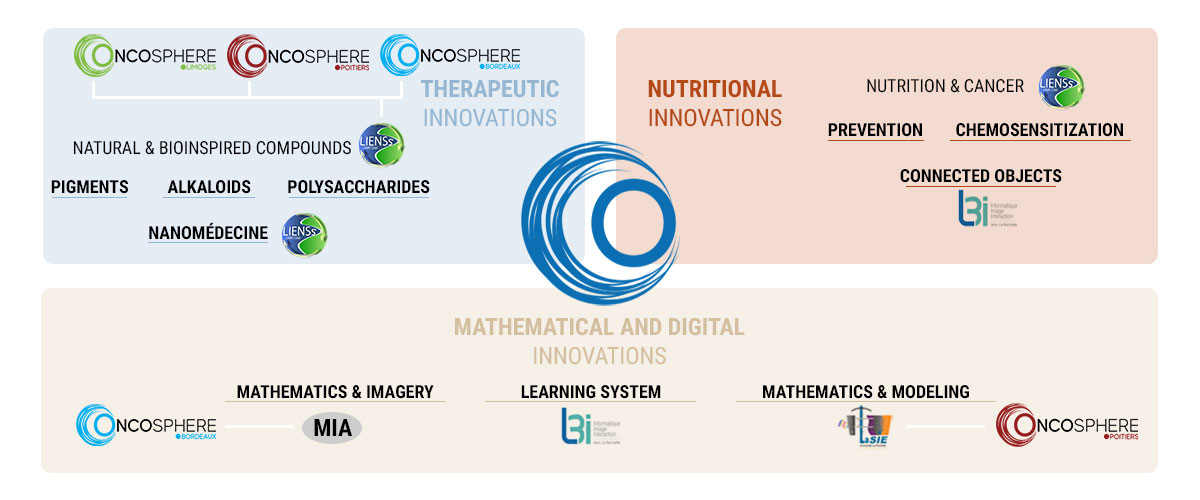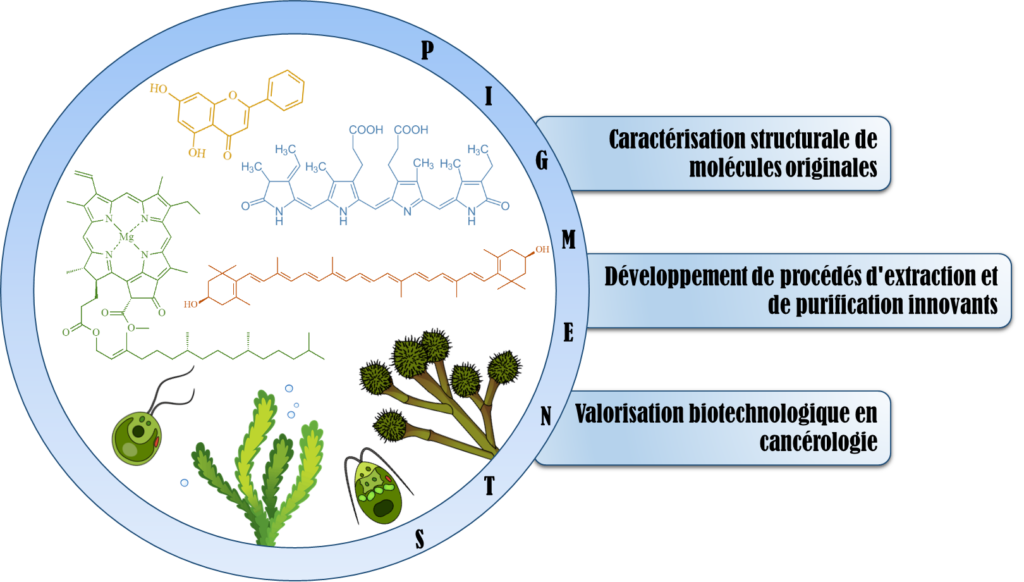THE SITES
LA ROCHELLE


La Rochelle Oncosphere brings together four Science and Technology research units, two under CNRS supervision (UMR7266 Littoral Environnement Sociétés, LIENSS; UMR 7356 Laboratory for the Application of Engineering and Environmental Sciences, LASIE) and two reception teams (EA 2118 Computer Science, Image, Interaction, L3i; EA Mathematics Images Applications, MIA). These research teams are all located on the site of the university’s Faculty of Sciences. Only part of the research activities of these units is reserved for cancer and overall represents around thirty researchers, several doctoral students and post-docs.
The Rochelais site offers an oncosphere mobilizing researchers from Science and Technology. The site project, interdisciplinary, combines biotechnologies with chemical sciences, ecological, mathematical and numerical sciences. All of these disciplines aim to develop new therapeutic, nutritional, mathematical, digital and technological solutions constituting as many possible innovations that can be transferred to the clinic.
Steering committee members

Pr Ingrid
ARNAUDIN
Description of the research units forming the Oncosphere:
The CNRS LIENSs unit (director Olivier De Viron) through several members of its team of “Biotechnologies and Chemistry of Bioresources for Health is specialized in the eco-design and evaluation of new natural pharmaco-modulators. for anticancer purposes, whether produced by extraction from natural animal or plant matrices (macro- and micro-algae, plants, marine bacteria, etc.) or by chemical synthesis or by biotechnology. These new pharmacological agents (pigments, marine sugars and synthetic heterocycles) are used in the prevention, diagnosis and targeted treatment of cancers (development of nanovectors). They find their particular prospects in the treatment of tumors (breast and melanoma) and the development of contrast agents for MRI imaging (work by Ingrid Arnaudin, Thierry Maugard, Laurent Picot, Valérie Thiéry and Hugo Groult).
Its AMARE team “Responses of Marine Animals to Environmental Variability” aims to study the impact of oncogenic processes on the ecology and evolution of wild organisms (birds, mammals, bivalves). More specifically, it proposes to (1) determine the prevalence and distribution of tumors in wild populations and the impact of cancer processes on resource allocation trade-offs using longitudinal and experimental approaches, to (2) test whether the life history traits of the species predict the prevalence of tumors measured in the field using comparative analyzes and (3) measure the impact of human activities on the prevalence of cancers (work by Mathieu Giraudeau).
The CNRS LASIE unit (director Xavier Feaugas) is developing research on the modeling of tumor growth (low-grade gliomas). This consists first of all in developing a mathematical model based on partial differential equations, to simulate the development of brain tumors, and to study the influence of the environment (nutrients, treatments, etc.) on the growth of the tumor. Once the model has been developed, the second step is to validate the predictions obtained by the numerical simulations by comparing them with medical data. This comparison is obviously a necessary step in order to be able to offer this model to doctors. This research is carried out by Cyrille Allery and Laurence Cherfils of LaSIE, in collaboration with the Poitiers University Hospital and the Dactim team of the Poitiers mathematics laboratory. Hussein Raad, doctoral student at LaSIE, started a thesis on the subject in October 2020.
In addition, Marc Garbey and Stefano Casarin, researchers at Houston Methodist Hospital, USA, and associated researchers at LaSIE, are also carrying out their research in the field of oncology (digital surgery, modeling for prostate cancer, etc.)
The MIA unit has developed a strong expertise in mathematical image processing and analysis, mainly concerning multidimensional and/or multimodal acquisition. Breakthrough approaches are dedicated to the design of new specific tools for color information treatment as well as for the extraction of relevant information in multidimensional signals. Beside the production of efficient algorithms of segmentation, classification, restauration, etc, theoretical works are devoted to the mathematical aspects of harmonic theory for higher dimensional signals. The team is composed of pure and applied mathematicians together with researchers in signal processing and computer science. In 2018, the MIA laboratory developed the first algorithm to segment cancerous tumors in real time and in 3D in high-frequency ultrasound ultrasound images (Bertier Michel team, Catherine Choquet).
The L3i unit (director Yacine Ghamri) through its researchers has developed a research strategy focused on the intelligent and interactive management of digital content. The Images and Content team works more specifically on image processing and analysis and pattern recognition, notably by proposing approaches based on artificial intelligence techniques such as deep learning. In this context, the work currently in process aims to identify the presence of cancerous tumors. The work focuses in particular on the analysis of CT-scan images (computerized tomography) for the detection and classification of lung tumors and melanomas for skin cancer (team Jean-Christophe Burie, Antoine Doucet).
This consortium of researchers will tackle the issues:
- renewal of the therapeutic arsenal dedicated to the treatment of cancer,
- the potentiation of the effectiveness of new anti-cancer compounds by applying nanomedicine principles to them,
- simulation of tumor development by introducing new mathematical, ecological and numerical models,
- image analysis and processing (3D segmentation) through the application of deep learning techniques or new mathematical algorithms.
It will be able to rely on the technological platforms dedicated to digital, biotechnology and ecology present within the university campus forming the oncosphere. It will take advantage of the BIOAQTIV biotechnology maturation platform for the production of small GMP-standardized pilot batches, which by 2022 will offer cutting-edge equipment meeting ATEX standards such as analytical equipment (liquid and gas chromatography systems coupled with spectrometry mass, super-critical fluid chromatography system), asset stability measurement equipment (climatic chamber with temperature and humidity regulation in accordance with ICH standards), bioreactors (1L, 2.5L, 30L and 300L), maceration and purification tanks of active ingredients on a pilot scale (100L) as well as equipment dedicated to formulation operations (fluidized air bed system for drying, mixing, agglomeration and coating of powders, granules and pellets at laboratory scale, spray drying system at laboratory scale).
Some figures – existing strengths
The strengths and expertise of the La Rochelle site are:
1) in biochemistry and synthetic chemistry for the renewal of the therapeutic arsenal by exploration of marine bio- and chemiodiversity or by biomimicry (organic synthesis),
2) in experimental biology, pharmacology and enzymology for the evaluation of the anti-cancer activities of pharmaco-modulators, particularly those capable of reducing tumor progression (tumor neovascularization, invasion / migration, activity of key kinases and endoglucuronidases) and the resistance of tumor cells to chemotherapy,,
3) in biotechnological, mathematical and digital innovations for medical imaging and targeted delivery
– by the development of new nano-technological means offering molecules with original biological and chemical properties for MRI imaging and cancer therapys,
– by mathematical processing and analysis of data from medical imaging for the purposes of modeling tumor growth or 3D segmentation,
– by applying deep learning techniques to identify cancerous tumors of the skin.
4) in evolutionary ecology to provide new models and concepts for the study of oncogenic processes







